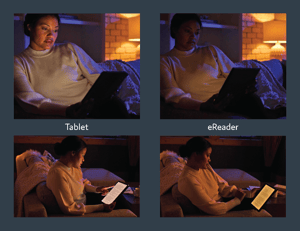Liquid Crystal Displays (a.k.a. LCDs) are everywhere. Computer monitors, phone screens, outdoor signage, advertising billboards – you name it. As technologies like 5G connectivity and AI mature, we are seeing LCDs of all sizes being woven into our daily lives.
Artificial, bright lights radiating from these digital screens – specifically blue light – have negative effects on our eyes and our health overall. While most of us are aware of the potential impact of blue light exposure, the effects are far worse.
As LCD screens get integrated into smaller handheld devices or wearables, they are bringing blue light closer to our eyes, and for longer durations than ever before. In fact, the average adult spends about 13 hours per day behind a screen. Just check the screen time on your phone, how many hours are you already at today?
So…What Are My Options?
LCDs are not the only type of display. ePaper like E Ink-powered screens are, in fact, a healthier display option. A study from Harvard School of Public Health backs up this claim. The study found that displays with brighter, bluer (or cooler) light from LCDs cause higher levels of stress on retinal cells, and ePaper is up to three times healthier for our eyes.
You might ask: what exactly is the difference between LCDs and ePaper displays?
They have a key difference in the manner they use light. To view an image on an LCD screen, the displays use a backlight, usually LED-based, to push light through the LCD material. In contrast, E Ink's ePaper displays are just like paper: they do not emit any light.

Credit: E Ink
Think of it this way: LCDs shine from within, whereas ePaper reflects off ambient light – from the sun outside or artificial lighting indoors. It’s the reason ePaper is perfect for reading at the beach, while the LCD tablet is hard to see under direct sunlight.
Ambient Light’s Effect on LCD Screens
While ambient light is important for ePaper readability, what does it do to LCDs or emissive displays?
It actually creates a problem. The reflection caused by ambient light makes LCD screens much harder to read in daylight. When we have to turn the brightness level all the way up on our smartphone devices under direct sunlight – that’s a good example of how emissive displays interact with ambient light. Screens with high brightness levels – designed for outdoor viewing – can be especially damaging to the eye when used in dim and dark indoor environments.
Check out this whitepaper with more helpful information on the differences between emissive LCDs and ePaper displays. It also demonstrates how our eyes engage with light sources under different circumstances.
If We Can’t Totally Disconnect, Let’s Choose a Healthier Screen Option
The Harvard study examined the E Ink ComfortGaze™, and found that compared to the LCD screen, the eReader with ComfortGaze front light can be read much longer before retinal cells get tired and start showing signs of stress.

Credit: reMarkable
As our world gets more digital, the findings from the study further highlight the importance of eye health and safety. Today’s younger generations grew up with social media. It’s their preferred platform for learning, entertainment, and engaging with each other and their community. They are at the greatest risk of blue light exposure.
Not all screens are the same. While it’s not realistic to unplug from the digital world, how about shifting a portion of the screen time to devices that are healthier for our eyes?


Leave Comment